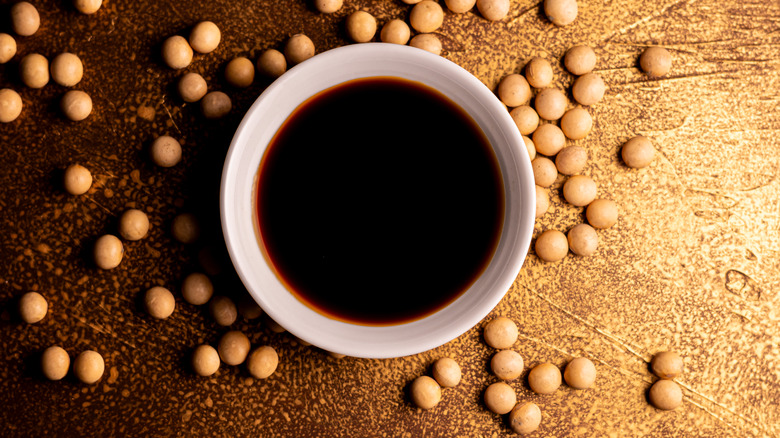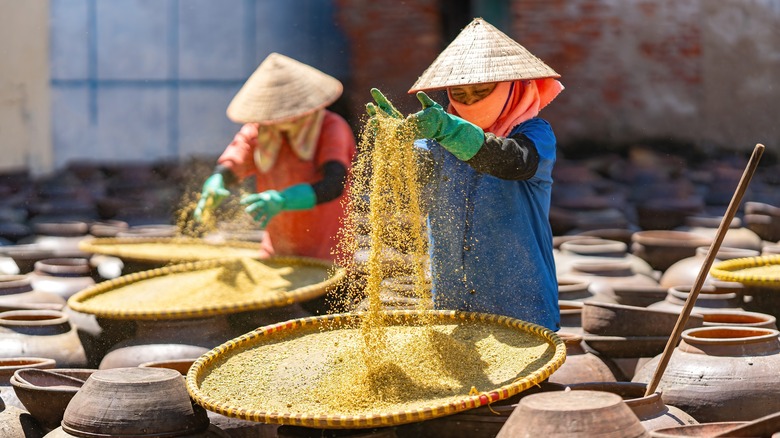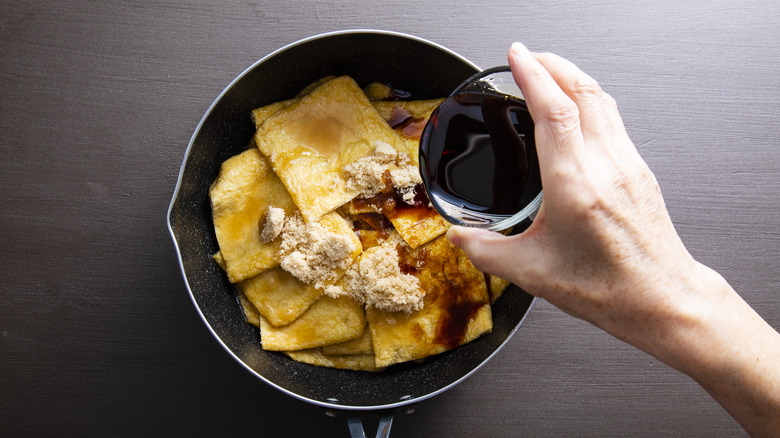What Is Soy Sauce Made From?
While this rich umami seasoning plays a big role in Asian cuisine and culture, soy sauce is loved all around the world. Much like Worcestershire sauce, soy sauce's allure lies in its addictively savory, salty flavors, which makes it a well-rounded topping that can pair with just about anything. This versatile sauce can balance out the pH levels of dishes with its acidic makeup, or add unique flavors and colors. All those benefits and more means this condiment graces the fridges and pantries of people worldwide. Still, while it might have a permanent spot on shelves everywhere, does anyone know exactly what's inside?
While every batch of soy sauce is different, most of these sauces are made up of a simple combination of salt, wheat, and soybeans as the main ingredients. The soybeans are usually fermented with an acid or other agent like mold to help extract its signature strong flavor. (For a specific example, the popular brand Kikkoman uses soybeans, wheat, salt, and water to make their sauces.) So, for all our gluten-free friends, steer clear of soy sauce, or at least read the label before purchasing.
The fermentation process for soy sauce can take anywhere from six months to three years to complete. Still, since time and patience leads to a perfectly umami end product, we'd say it's worth the wait.
The changing face of soy sauce production
Most modern producers of soy sauce rely on unique chemical processes to speed up that long fermentation process, such as mixing soybeans with hydrochloric acid to help the proteins break down faster. Prior to this era however, in the early days of soy sauce back in ancient China, producers crafted this condiment by soaking soybeans in water and combining it with wheat and bacteria instead. This mixture was then cooked down to help it all mesh together, then fermented and aged until complete.
In addition to the ever-changing creation process of soy sauce, there are many different varieties of this sauce too. Some options are thinner and sweet, others syrup-like and savory, so there are plenty of variations out there to try. Still, while there are hundreds of fun options, the Japanese Ministry of Agriculture, Forestry and Fisheries defines just five distinct categories of soy sauce: light and dark soy sauce, white soy, twice-brewed, and traditional. (Or, using their traditional names, usukuchi, koikuchi, shiro, saishikomi, and tamari.) Some of those sauces are made without wheat, which makes some an option for gluten-free foodies too.
All the different varieties of soy sauce
Shiro soy sauce, or white, is a lighter version of soy sauce made primarily from wheat. This subtle take on traditional soy sauce is best used to simply enhance the flavor of a dish. Usukuchi, or light soy sauce, is more flavorful than shiro, and has a paler hue than the traditional varieties. Koikuchi, or dark soy, makes up 80% of the soy sauce on the market and is super versatile. Saishikomi, or twice-brewed sauce, has a longer fermentation process and is a huge flavor bomb. And finally, tamari is a traditional soy sauce made with less water than other varieties, so it has a thicker texture that's great for dipping.
Because of the well-rounded flavors of soy sauce in general, there's a lot the sauce can pair well with. Within these condiments, all five of the basic tastes are represented from salty, sweet, sour, bitter, and, of course, umami. This is what makes soy sauce such a staple, versatile, all-purpose condiment. It's a flavorful fit for any dish in your back pocket from fried eggs to lush bowls of protein and rice. (And if you want to make your fried rice truly unforgettable, try adding this one extra ingredient too.) Now that you know what this popular Japanese condiment is all about, let's dig into what fish sauce is next.


